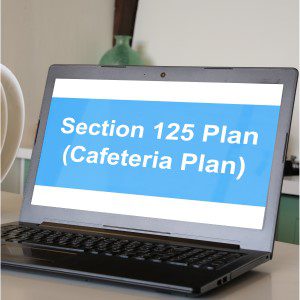
A Section 125 Cafeteria Plan is an employer-sponsored benefits program that lets employees pay for certain qualified medical expenses, such as health insurance premiums, on a pre-tax basis. It’s called a “cafeteria plan” because, like the dining options at a cafeteria, employees can pick and choose the healthcare options they want, such as medical, dental, vision, and other benefits, while declining ones they don’t.
It’s important to note that a Section 125 Cafeteria Plan does not provide health insurance. Instead, it allows employees to use pre-tax money to choose and pay for the benefits they find valuable, which may include health insurance among others.
Section 125 Cafeteria Plan Requirements
Cafeteria Plans must include the following:
- At least one taxable benefit option that is considered part of the employee’s salary, and
- At least one qualified pre-tax benefit
Regarding the taxable benefit option, for employees who opt into a Section 125 Cafeteria Plan, the employer may offer the cost of their traditional group healthcare plan premium as a cash addition to employees’ salaries. The employee may use that money towards another benefit. However, if the employee receives this contribution as cash, that money is taxed. Employees who opt out of the cafeteria plan may not receive the premium cost amount as compensation.
Qualified pre-tax benefits can range from health and disability insurance to Flexible Spending Accounts (FSAs), Dependent Care Assistance Plans (DCAP), Health Savings Accounts (HSAs), and contributions toward retirement plans.
Cafeteria Plan Benefits for Employees
The primary advantage of a Cafeteria Plan to employees is the range of healthcare options they can acquire with Section 125 money to fit their needs. Typically, these pre-tax options include health insurance premiums, retirement contributions, or other benefit options. If they don’t want any of the offered benefits, they may be able to choose alternatives, including cash, supplemental life insurance, or disability insurance. In addition, employees may lower their taxes by contributing to the Cafeteria Plan before tax deduction calculations. The following Section 125 Cafeteria Plan options offer significant tax and money-saving advantages for employees:
- Flexible Spending Accounts (FSAs). An FSA allows employees to pay for qualified out-of-pocket medical expenses pre-tax.
- Health Savings Accounts (HSAs). Like an FSA, HSAs enable setting aside pre-tax money for various approved healthcare products and services. Unlike FSAs, employees own their HSA accounts and can take them with them if they leave.
- Dependent Care Flexible Spending Accounts (DCFSAs). Also known as Dependent Care Assistance Plans (DCAP), this benefit allows setting aside up to $5,000 per year pre-tax to pay for dependent care services. This benefit enables working parents to save on child care (or for the care of elderly or disabled dependents unable to care for themselves) while working or attending school.
Cafeteria Plan Benefits for Employers
Section 125 Cafeteria Plans also provide several significant advantages to employers, especially small business owners.
- Employees who participate in a Section 125 Cafeteria Plan have reduced payroll taxes. As a result, the employer’s FICA matching, FUTA, SUTA, and Workers’ Compensation costs are also lower.
- Lower payroll taxes can help reduce or offset the costs of offering the cafeteria plan.
- Offering a more attractive benefits package may reduce turnover and attract new talent.
- Unused funds in FSA accounts with “use it or lose it” provisions are forfeited to the employer at the plan year’s end or when an employee leaves the company.
Cafeteria Plan Points of Interest
Although Cafeteria Plans benefit both employees and employers, certain points merit consideration.
- Section 125 Cafeteria Plans, which vary depending on the employer’s needs, can be complicated to implement and administer.
- Section 125 plans lock employees into their designated contributions for an entire year. With few exceptions, employees must wait until the following enrollment season to make plan changes.
- Employees who don’t use all their FSA money in the calendar year may be able to roll a limited amount over to the following year or have extra time to use unspent funds. However, unspent funds that don’t meet these provisions are forfeited to the employer. This may also occur if they leave employment with unspent funds in their FSA account.
Section 125 Cafeteria Plans offer cost-effective benefits for companies. It can help businesses save money while meeting diverse employee needs. Contact a qualified third-party benefits administrator or benefits counsel for assistance with plan creation and compliance issues.
For 40 years, DataPath has been a pivotal force in the employee benefits, financial services, and insurance industries. The company’s flagship DataPath Summit platform offers an integrated solution for managing CDH, HSA, Well-Being, COBRA, and Billing. Through its partnership with Accelergent Growth Solutions, DataPath also offers expert BPO services, automation, outsourced customer service, and award-winning marketing services.

